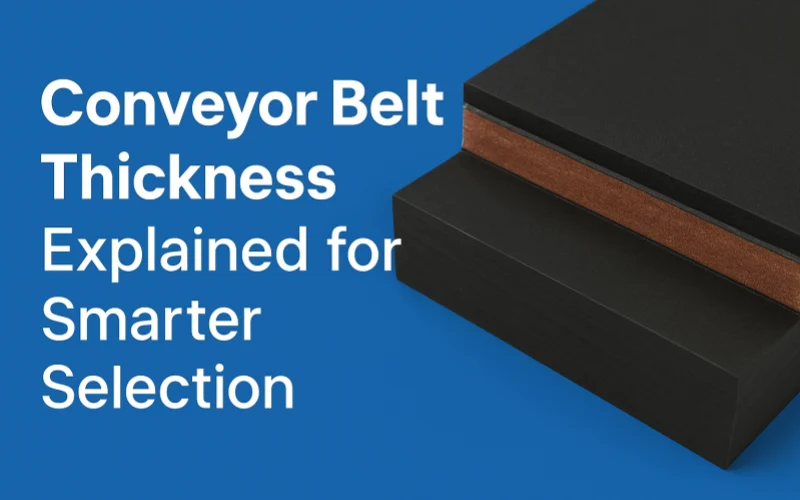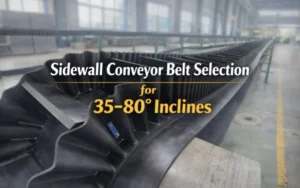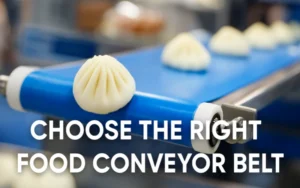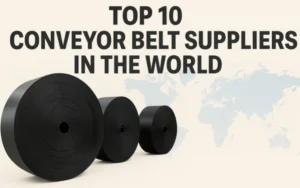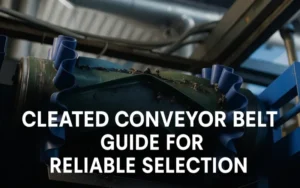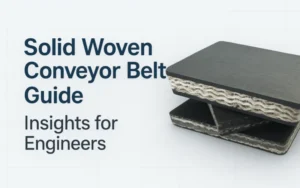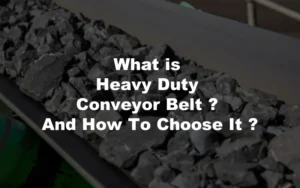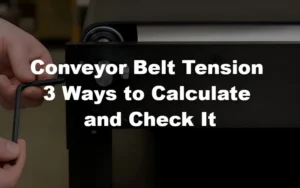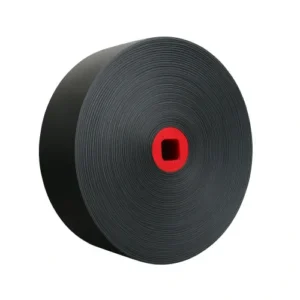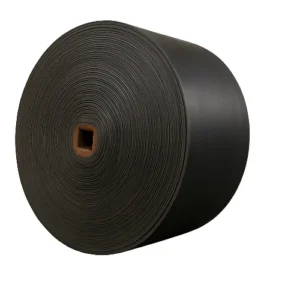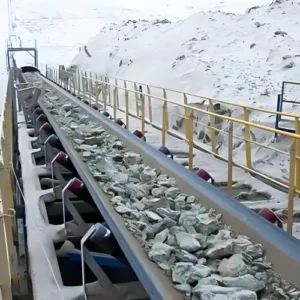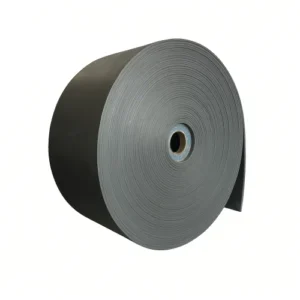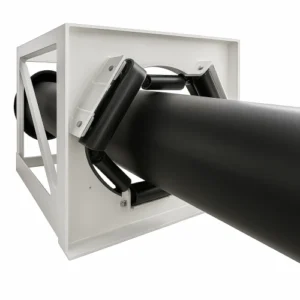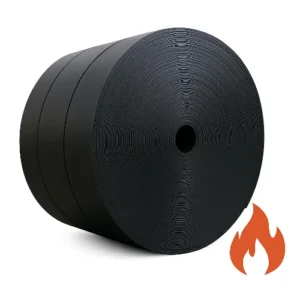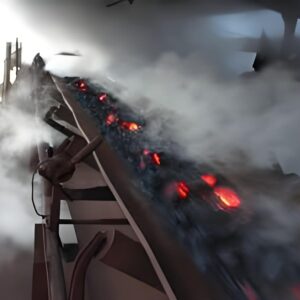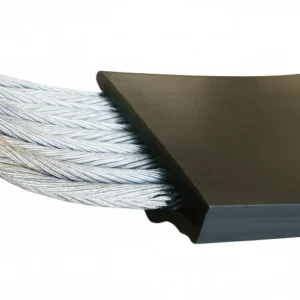1.Conveyor Belt Thickness Explained
It’s a familiar scene for anyone in the conveyor business. You open your inbox to a client request. They’ve attached specs for belt width, length, even the tensile strength—but not a word about conveyor belt thickness. It’s like ordering a pizza and forgetting the dough. A minor oversight? Not quite. In reality, it’s one of the most critical parameters when designing industrial conveyor belts.
Now, let’s clear something up: conveyor belt thickness isn’t just a single number plucked from thin air. It’s a composite—like a good lasagna, it’s all about the layers. The full thickness is the sum of:
- Top cover thickness
- Carcass (core fabric) thickness
- Calendered (skim) rubber layer thickness(Usually we estimate it in unison with the Carcass thickness.)
- Bottom cover thickness
When someone says “we want a 12mm belt,” it’s worth asking—which 12mm are we talking about? Because each layer plays a different role in performance, longevity, and the elusive goal of optimal conveyor belt performance.

1.1 Not All Thickness Is Created Equal
In the real world, the thickness you choose has downstream effects (pun fully intended). The top rubber cover is your belt’s armor—it resists abrasion from bulk materials. The bottom cover deals with pulleys and rollers, where friction and traction come into play. The core is the muscle, often made of EP or nylon fabric, giving the belt its strength. And the skim layer? That’s the glue keeping things honest, ensuring layer adhesion and durability.
Overestimate thickness, and you’ll burn unnecessary energy on excessive mass. Underestimate it, and you’ll be spending more time on conveyor belt maintenance than you do actually moving material. And while it may sound like an easy balance, field engineers will tell you—most premature failures start with poor decisions around thickness.
1.2 Thickness Affects More Than Just Wear
Let’s break it down by impact. Thicker belts generally:
- Improve conveyor belt durabilityin abrasive or heavy-duty applications
- Reduce the need for frequent measuring conveyor belt thicknesschecks (though regular inspection is still crucial)
- Support heavier loads but at the expense of bending flexibility
- Require precise tension calibration for proper alignment
However, thicker isn’t always better. If your system has tight pulleys or sharp curves, that beefy belt might resist flexing like a stiff-necked retiree.
1.3 Industrial Examples: The Good, The Bad, The Misunderstood
In mining or cement plants, belts often run 16–25mm thick, with reinforced carcasses and extra-thick top covers. That’s not luxury—it’s survival. A thin belt would tear faster than a budget raincoat. On the flip side, in food packaging lines where hygiene and speed matter more than brute strength, a 5mm belt might do the trick.
What’s more, ISO and DIN standards also reference specific conveyor belt specifications for thickness based on industry and use-case. Choosing outside those guidelines isn’t innovation—it’s gambling.

1.4 Thickness Tolerances & Engineering Reality
No belt is “exactly 12.00mm.” Tolerances matter. Most manufacturers operate within ±0.5mm or ±0.8mm depending on the conveyor belt types. Engineers working on tight clearances or specific tensioning systems should always verify actual thickness before installation. Misjudging it? That’s how belts go off-track—literally.
So yes, conveyor belt thickness may be just one line item on a spec sheet—but ignore it, and you’re building a machine on guesswork. In the world of selecting conveyor belt thickness, precision is more than just smart—it’s essential.
2.Conveyor Belt Thickness by Type: Fabric Constructions and Special Core Profiles
In the world of industrial conveyor belts, thickness isn’t just a number—it’s a reflection of structural intent. Whether it’s a fabric-reinforced belt used in packaging or a steel cord giant moving ore across a continent, conveyor belt thickness reflects not only durability but also function, load capacity, and system design.
I have attached the Carcass thickness of the three materials EP, NN, and ST below for your reference.
| Carcass | Carcas s Type | Carcass Thickness (mm/p) | Strength(N/mm) | Cover Thickness (mm) | Width (mm) | |||||
| 2ply | 3ply | 4ply | 5ply | 6ply | top cover | bottom cover | ||||
| EP | EP100 | 1 | 200 | 300 | 400 | 500 | 600 | 1.5-30 | 1.5-20 | 300-3500 |
| EP125 | 1 | 250 | 375 | 500 | 625 | 750 | ||||
| EP150 | 1.1 | 300 | 450 | 600 | 750 | 900 | ||||
| EP200 | 1.2 | 400 | 600 | 800 | 1000 | 1200 | ||||
| EP250 | 1.4 | 500 | 750 | 1000 | 1250 | 1500 | ||||
| EP300 | 1.6 | 600 | 900 | 1200 | 1500 | 1800 | 2-30 | 2-20 | ||
| EP350 | 1.7 | 700 | 1050 | 1400 | 1750 | 2100 | ||||
| EP400 | 1.9 | 800 | 1200 | 1600 | 2000 | 2400 | ||||
| EP500 | 2.1 | 1000 | 1500 | 2000 | 2500 | 3000 | ||||
| EP630 | 2.6 | 1260 | 1890 | 2520 | 3150 | 3780 | ||||
| NN | NN100 | 1 | 200 | 300 | 400 | 500 | 600 | 1.5-30 | 1.5-20 | |
| NN125 | 1 | 250 | 375 | 500 | 625 | 750 | ||||
| NN150 | 1.1 | 300 | 450 | 600 | 750 | 900 | ||||
| NN200 | 1.2 | 400 | 600 | 800 | 1000 | 1200 | ||||
| NN250 | 1.4 | 500 | 750 | 1000 | 1250 | 1500 | ||||
| NN300 | 1.6 | 600 | 900 | 1200 | 1500 | 1800 | 2-30 | 2-20 | ||
| NN350 | 1.7 | 700 | 1050 | 1400 | 1750 | 2100 | ||||
| NN400 | 1.9 | 800 | 1200 | 1600 | 2000 | 2400 | ||||
| NN500 | 2.1 | 1000 | 1500 | 2000 | 2500 | 3000 | ||||
| NN630 | 2.6 | 1260 | 1890 | 2520 | 3150 | 3780 | ||||
| CC | CC56 | 1.1 | 112 | 168 | 224 | 280 | 336 | 1.5-30 | 1.5-20 | |
| TC | TC70 | 1 | 140 | 210 | 280 | 350 | 420 | 1.5-30 | 1.5-20 | |
2.1 Fabric Conveyor Belts: The Backbone of Industrial Transport
Fabric belts are among the most common in the industry. They rely on layered synthetic fabrics (typically EP or NN) reinforced with rubber. Here’s where the misunderstanding often begins: people assume that the number of plies tells you the full thickness. Not quite.
The key to understanding fabric belt thickness is this: the ply thickness includes both the fabric and the skim rubber layer between plies. For a standard EP300-rated fabric, this composite layer (fabric + skim) is typically about 1.6mm per ply—though it can range between 1.0 to 2.6mm depending on the EP rating.
Let’s walk through a realistic example:
Example: You’re quoting a 3-ply EP300 rubber conveyor belt with a 5mm top cover and 3mm bottom cover.
Calculation:
Fabric section = 1.6mm × 3 = 4.8mm
Total thickness = 4.8mm + 5mm (top) + 3mm (bottom) = 12.8mm
That’s the real, structurally-informed conveyor belt thickness—not just a guess, but a measurable, repeatable value based on materials and design logic.
2.2 Typical Fabric Belt Types & Thickness Ranges
Ply Structure | Belt Type | Typical Thickness |
2-ply | EP150/EP200 | 8–10mm |
3-ply | EP250–EP300 | 10–14mm |
4-ply | EP300–EP400 | 14–18mm |
5-ply | EP400–EP500 | 18–25mm |
Each additional ply adds tensile strength and contributes to conveyor belt durability, but also reduces flexibility. That’s why matching the correct ply structure and conveyor belt specifications to the application is essential.
2.3 Special Cores, Special Thickness Profiles
Not every belt is made of fabric. For extreme conditions—high tension, fire risk, or ultra-heavy loads—fabric won’t cut it. Enter special core belts: steel cord and solid woven types, each with their own logic and conveyor belt thickness profiles.
2.3.1 Steel Cord Conveyor Belts (ST Series)
Designed for the toughest jobs, steel cord belts are built to carry tons of bulk material over long distances with minimal stretch. Their conveyor belt thickness usually ranges from 12mm to 25mm, driven by three key factors:
- Cord diameter and spacing
- Cover rubber thickness(typically 4–8mm top, 3–6mm bottom)
- Skim rubber and anti-corrosion layers
Even though steel cord belts may have fewer visible layers than fabric belts, they offer maximum conveyor belt durability, especially in operations where elongation control (≤0.25%) and rigidity are critical.

2.3.2 Solid Woven Fire-Resistant Belts (PVG)
Used extensively in underground coal mines, these belts are designed for flame resistance and anti-static safety, not just mechanical strength.
- PVG belts: With top rubber cover ≥1.5mm to meet MT668 safety standards, these belts range from 8–12mm Their top layer improves wear resistance while preserving safety compliance.

While not as thick as steel cord belts, these types serve niche roles where conveyor belt specifications are driven by regulatory and environmental factors more than loading capacity.
2.4 Matching Thickness to Application
A belt too thin may wear prematurely; a belt too thick may create tension problems or system inefficiencies. Below is a simplified reference table that matches belt types, cores, and typical conveyor belt thickness values to common industrial sectors:
Application | Core Type | Typical Thickness |
Fertilizer Packaging | 2-ply EP150 | 8–10mm |
Concrete Block Plant | 3-ply EP300 | 12–14mm |
Stone Crushing Plant | 4-ply EP400 | 16–18mm |
Surface Mining | ST1250 | 18–22mm |
Underground Coal | PVG Solid Woven | 8–12mm |
Understanding these correlations helps in selecting conveyor belt thickness that balances wear life, energy usage, and handling capacity.
In short, conveyor belt thickness isn’t arbitrary—it’s an engineered outcome. Whether you’re specifying a belt for a mine, a port, or a factory floor, start with your load and application, then build your belt profile from the inside out.
3.Selecting Conveyor Belt Thickness: Engineering the Right Fit for Heavy-Duty Applications
There’s an odd trend in the world of conveyor belt inquiries. Clients will send over detailed specs—belt width, tensile strength, length to the decimal—then leave a blank space where the conveyor belt thickness should be. It’s like building a skyscraper and forgetting to mention how thick the walls need to be. “Make it strong” isn’t quite a metric we can design around.
In the world of industrial conveyor belts, thickness isn’t a formality. It’s a frontline defense against impact, wear, misalignment, and premature failure. Selecting the proper thickness isn’t about going “as thick as possible.” It’s about engineering a solution that matches the material, speed, system constraints, and environment in which your belt must survive—day after day, ton after ton.
3.1 Start with What You’re Moving
Material properties are the foundation of every thickness decision. The wrong belt for the wrong material is how you end up with mid-shift breakdowns and extra maintenance invoices.
- High-density materials like iron ore, bauxite, or crushed aggregate apply greater pressure and require more internal support and thicker rubber covers.
- Sharp and abrasive particles such as gravel or clinker wear down the top cover quickly. Thicker top layers (6mm or more) act as sacrificial armor to extend belt life.
- Sticky or moist loads, like wet limestone or coal, often demand a thicker bottom cover to improve traction and prevent material buildup near pulleys.
Understanding the physical nature of the load gives context to how much conveyor belt thickness is truly needed—no more, no less.

3.2 Conveyor Speed, Load, and Runtime: The Three-Headed Equation
How fast the belt moves, how far it travels, and how long it runs daily are critical variables when selecting conveyor belt thickness:
- Speed matters. Belts operating above 3.5 m/s endure more frequent impact events. This repetitive contact creates micro-traumas in the rubber. A thicker top cover helps absorb this high-frequency abuse.
- Long conveyors—like those found in mines or cement yards—often need stiffer, thicker constructions to prevent sag, resist tension, and maintain tracking stability.
- Continuous operation? If your system runs 20+ hours daily, choosing a thinner, cheaper belt to save cost is a false economy. Thicker belts reduce wear rates, minimize shutdowns, and cut the frequency of conveyor belt maintenance.
In essence, your operating profile defines your belt’s workload. The thickness just reflects what your system needs to handle it without breaking a sweat.

3.3 Impact Matters More Than You Think
Now for the unspoken saboteur of belts: vertical impact. If material free-falls from a height—like in crushers, feeders, or loading zones—standard covers won’t last. That’s where dynamic thickness compensation steps in.
Real-world fix: A stone quarry upgraded its 3-ply EP300 belt from a 5mm top cover to 8mm after noticing early delamination at impact zones. The result? A 60% increase in lifespan and a noticeable drop in unscheduled shutdowns.
Extra millimeters up top help distribute impact force, protect internal plies, and act as a shock absorber. It’s not waste—it’s insurance.
3.4 Pulley Diameter vs. Flexural Fatigue
Every bend over a pulley is a stress event. While one bend may not do much, thousands per day on an oversized belt wrapped around an undersized pulley leads to flexural fatigue.
- For pulleys under 250mm: use belts ≤12mm total thickness.
- For pulleys above 400mm: up to 25mm is appropriate, depending on ply and speed.
Going too thick in a tight system is like wearing hiking boots on a trampoline—stiff, inefficient, and likely to end in failure. Match the belt’s bending profile to pulley constraints to avoid cracking the core from the inside out.
3.5 Environmental Conditions Aren’t Optional
Your conveyor doesn’t operate in a vacuum. It’s exposed to real-world abuse from temperature swings, dust, moisture, UV radiation, and sometimes chemicals. These all demand a second look at your conveyor belt specifications:
Environment | Required Thickness Adjustment |
High temperature (>40°C) | +15% top cover |
Acidic exposure (pH < 3) | +25–30% total thickness |
High UV (outdoor, high altitude) | Add 1mm to all covers |
Constant humidity or water spray | Use thicker bottom cover + sealed edges |
Ignoring these factors is how good belts fail early—not because of bad design, but because of misapplied design.
3.6 Real-World Cases: Belt Choices That Made (or Saved) Money
Case A: Iron Ore Mine – Long-Distance Bulk Haul
- Material: Iron ore, 35mm avg particle
- Speed: 3.0 m/s
- Length: 200m
- Belt: 5-ply EP500, 8+4mm covers
- Thickness: 17mm
- Why it worked: High abrasion load, long runtime, and need for rigidity demanded a thick, reinforced belt. The top cover handled sharp impacts, and the thick carcass gave the belt minimal stretch under constant load.
Case B: Cement Plant Clinker Transfer Line
- Material: Hot clinker at 180°C
- Speed: 2.5 m/s
- Length: 90m
- Belt: 4-ply EP400, 6+3mm heat-resistant covers
- Thickness: 13mm
- Why it worked: Standard belts couldn’t withstand the combination of heat and abrasion. The upgraded thickness not only extended lifespan by 2x but also improved belt tracking under thermal expansion.
In both cases, conveyor belt thickness wasn’t just about numbers—it was about matching reality to design, and performance to pressure.
3.7 The Selection Method: From Theory to Practical Decision
A proven approach to selecting the right thickness involves:
- Defining the material—including density, shape, and moisture
- Profiling the system—speed, length, load rate, runtime
- Evaluating environment—temperature, pH, UV, humidity
- Choosing core strength—ply count based on load and pulley compatibility
- Setting top and bottom covers—thicker where impact and wear are critical
- Applying environmental and impact corrections—turning raw specs into resilient design
The result isn’t just a belt that meets specs. It’s a belt that survives your operation—and maybe even outperforms expectations.
In short, choosing conveyor belt thickness isn’t a checkbox. It’s a design strategy. When done right, the belt becomes an asset, not a consumable. And in industries where uptime is money, the right thickness is worth every calculated millimeter.
4.How to Use Conveyor Belt Thickness Reference Tables Effectively
In theory, conveyor belt thickness charts are meant to simplify your selection process. In practice, they often raise more questions than they answer—especially if you’re not familiar with how these numbers are calculated. These tables are only useful when you understand what’s behind the values: the structure of the belt, the assumptions behind its application, and how to adjust those numbers for your specific working environment.
4.1 Understanding How Thickness is Calculated
The total conveyor belt thickness isn’t just a random figure pulled from a catalog—it’s the sum of very real, measurable components:
Total Thickness
=
Top Cover Thickness + Bottom Cover Thickness + Carcass Thickness
The top cover is the working surface, designed to resist abrasion, impact, and chemical attack. The bottom cover protects the belt as it runs over pulleys and idlers. The carcass thickness—which includes the fabric layers (plies) and the skim rubber between them—gives the belt its strength and shape.
4.2 Tables Are Starting Points, Not Endpoints
Reference tables typically suggest standard combinations of covers and plies for “typical” conditions. They might recommend a 4-ply EP400 with 6+3mm covers for quarry use, or a 3-ply EP300 with 5+2mm covers for general construction.
However, these values assume:
- Controlled load conditions
- Standard material abrasion
- Minimal chemical or thermal stress
In short, these values are what we’d call “safe estimates”—they work well in average conditions, but rarely reflect extreme environments. For that reason, always interpret tables as guidelines, not guarantees.
4.3 Application Realities Require Adjustments
Tables don’t know your conveyor layout, material type, or failure history. You do.
So when should you deviate from the chart?
- High-impact zones: If your material free-falls from height or hits the belt with significant energy, increase the top cover thickness by 2–3mm beyond standard recommendations.
- Pulley-related wear: If your system has smaller-than-ideal pulleys or abrasive lagging, upgrade your bottom cover to prevent early wear—even if your chart suggests a thinner one.
- Edge cracking or moisture ingress: This suggests the standard belt isn’t protecting internal plies. Consider thicker covers, sealed edges, or an upgrade in rubber grade.
- Uneven wear between top and bottom: Adjust each side independently. There’s no rule that says both covers must increase proportionally.
This is the point where measuring conveyor belt thickness during maintenance cycles becomes valuable. If you’re wearing through the top cover while the carcass is untouched, then the cover—not the ply count—needs adjustment.

4.4 Don’t Blindly Trust “Standard”
Here’s a common trap: a plant runs the same 4-ply EP400 belt for five years, sees poor durability, and blames the supplier. But the actual cause? The operating conditions never matched what the chart assumed.
- Belt speed was 4.2 m/s instead of 2.5 m/s
- Material was oversized, sharp-edged slag—not rounded gravel
- The loading point was an 8-meter drop chute with minimal buffering
Even the best reference table can’t predict those specifics. So the correct use of the table is to start with the standard configuration, then challenge it using:
- Your site’s failure history
- Common wear patterns (impact, flex-fatigue, chemical)
- Maintenance data from similar belts or installations
4.5 Manufacturer Recommendations Are a Conversation, Not a Rulebook
When you request belt specs from a manufacturer, they’ll likely pull from the same tables. That doesn’t mean the numbers are wrong—it means they’re unadjusted.
Instead of asking, “Is this belt thick enough?” try:
- “Has this construction been tested under 24-hour load cycles?”
- “What’s the wear rate of this top cover in high-silica material?”
- “Can you provide average service hours from similar clients?”
Working with your supplier to validate conveyor belt specifications against real use cases transforms a generic recommendation into a performance guarantee.
4.6 Real-World Example: Adjusting for Cement Clinker, Not Just Thickness
Let’s say your supplier recommends a 4-ply EP350 with 6+3mm covers for a clinker belt. The chart suggests 16–17mm total thickness. You install it, and six months later, you’re scheduling an early replacement.
After investigation:
- Drop height was underestimated
- Ambient temp was regularly over 50°C
- Material contained fine dust with aggressive surface abrasion
Adjustment made:
- Top cover increased from 6mm to 8mm
- Carcass kept at 4-ply for pulley compatibility
- Heat-resistant rubber grade upgraded
Result: Belt lifespan increased by 80%, and visual inspections showed slower wear progression.
This is the real power of understanding—not just what thickness to use, but why that thickness works.

4.7 The Smart Way to Use Thickness Tables
Use thickness charts not to replace engineering, but to structure your thinking:
- Use the chart to estimate a starting spec based on load and ply logic
- Compare it with actual system wear patterns
- Identify top/bottom side failure modes
- Modify thickness and rubber grade accordingly
- Track wear data to refine future selection
The table is a guide. Field data makes it yours.
In summary, conveyor belt thickness reference charts offer a valuable framework—but they’re not bulletproof. The belts that last longest, perform most consistently, and save the most money are those selected not just by formula—but by experience, data, and targeted adaptation.
Because no table knows your operation better than you do.
5.Conveyor Belt Thickness Meets Rubber Grade: A Partnership That Moves the Industry
In the conveyor industry, it’s tempting to believe that a thicker belt is always a better belt. After all, more rubber must mean more durability, right? But if thickness is the skeleton of a belt, then the rubber grade is its personality. One gives it structure; the other, its behavior. And in many real-world applications, it’s not the thicker belt that wins—but the smarter one.
This distinction matters because many procurement decisions focus on conveyor belt thickness as the sole indicator of performance. Yet, belts of identical thickness can perform in dramatically different ways depending on their grade. If you’re specifying only by millimeters and ignoring what those millimeters are made of, you’re missing half the picture—and probably half the belt’s lifespan.
5.1 What Are Conveyor Belt Grades?
Rubber grades define the chemical and mechanical behavior of a belt’s cover, especially the top cover that takes the brunt of daily abuse. Grades are not aesthetic labels—they’re engineered formulas that respond to specific wear patterns, including:
- Abrasion
- Impact
- Heat and flame exposure
- Oil and chemical contact
Grades are often codified by standards like ISO 14890, DIN 22102, or MSHA flame resistance protocols. These are not suggestions; they’re survival requirements. A belt operating without the correct grade may look fine on day one, but check back after 90 days—it’ll be the weakest link in your production chain.
5.2 The Cast: Grade A, B, and C (And Why They Matter)
Let’s meet the stars of this rubber opera:
- Grade A (Abrasion Resistant)
This is your frontline soldier. Built for sand, gravel, limestone, and clinker. Combine it with a thick top cover (6–8mm), and you have a belt that survives long distances and aggressive materials.
Think:quarry boss or cement line veteran. - Grade B (General Purpose)
The workhorse of the industry. Handles moderate wear and impact in bulk handling environments. Often specified in 3–5 ply belts with standard covers.
Think:steady performer, but don’t ask it to do acrobatics. - Grade C (Impact Resistant)
Designed for sudden, sharp blows—think drop zones, crushers, and feeders. Often paired with elastic rubbers and reinforced bonding layers.
Think:the shock absorber in your system’s suspension.
- Grade A (Abrasion Resistant)
The twist? All three can have the same conveyor belt thickness, yet behave completely differently. So if you’ve ever wondered why two identical 16mm belts gave you wildly different service lives, now you know—it’s not the number, it’s the nature.
5.3 Thickness vs. Grade: Who’s Really in Charge?
Here’s a reality check: a poorly graded 20mm belt can fail faster than a well-designed 12mm belt with the right rubber. Why?
Because thickness without function is just mass.
And rubber without the right formulation is just expensive filler.
- Grade A needs the thickness to shield against abrasion.
- Grade C may benefit more from elasticity than sheer mass.
- Grade B sits in the middle, where small optimizations make a big difference.
That’s why conveyor belt specifications should never treat grade and thickness as independent. One dictates performance; the other determines how long that performance lasts.
5.4 Choosing Wisely: Matching Grade to Risk
Let’s simplify:
Operating Threat | Best Grade | Typical Top Cover |
High abrasion | A | 6–8mm |
Sudden impact | C | 5–7mm (elastic compound) |
Balanced duty | B | 4–6mm |
If you’re handling ore in a mining chute, don’t just look for a 7mm cover—look for Grade C rubber with high elongation and bonding strength. If you’re running limestone over 500 meters, prioritize Grade A with deep wear protection.
That’s how optimal conveyor belt performance is achieved—not just through thickness, but through strategic composition.
5.5 When Regulations Dictate More Than Logic
There are times when the choice is already made for you. Flame-resistant belts for underground mining, anti-static belts for fertilizer, or oil-resistant covers for material handling in recycling plants all require specific grades.
Even if your mechanical team says the conveyor belt thickness is correct, the safety inspector may have a different opinion—and they carry the shutdown authority.
5.6 A True Story of Grade Over Thickness
A client once insisted on a 5-ply EP500 belt with 8+3mm covers for a steel mill conveyor. On paper, the belt was nearly 24mm thick—impressive. In practice, it lasted 5 months.
The replacement? A 4-ply EP400 belt with 6+2mm covers but using high-grade abrasion and impact-resistant rubber (A+C). Total thickness: just 18mm.
The result: 15 months of uninterrupted service and a 40% reduction in total cost of ownership.
Sometimes, less is more—when “less” is better engineered.
5.7 A Belt Is More Than Its Thickness
Yes, conveyor belt thickness is critical—it tells you how much rubber and fabric you have to work with. But unless that thickness is paired with the right grade, it’s like using a lead pipe where a shock absorber is needed.
Your goal isn’t just to build a thick belt. It’s to build a smart belt—one where thickness and grade are synchronized for durability, compliance, and cost-efficiency.
Because in industrial material handling, the belt doesn’t just carry the load—it carries your bottom line.
6.Conveyor Belt Thickness Standards: Where Microns Meet Micro–politics
Ask any engineer what starts more debates than lunch orders and you might hear: conveyor belt thickness tolerances. For something so measurable, thickness seems to spark a lot of interpretation. Is it “nominal” or “actual”? Do we measure before vulcanization or after? Is 1.2mm under the spec a fatal sin—or just a friendly rounding error?
Welcome to the unspoken diplomacy of conveyor belt specifications, where millimeters are measured with microscopes and argued with megaphones.
6.1 Why We Need Standards (And Still Argue Anyway)
Standards like ISO 14890, DIN 22102, and ASTM D378 exist to stop conveyor chaos. They define what “thickness” really means, how to measure it, and what’s legally acceptable when that 14mm belt shows up measuring 13.3mm.
Without them, buyers would quote imaginary belts, manufacturers would ship guesswork, and maintenance teams would inherit the mess. So yes, we need standards—but let’s be honest, they’re just the start of the conversation.
6.2 ISO vs. DIN vs. ASTM: A Global Game of Inches
These are the big three in belt measurement:
- ISO 14890: The international diplomat. Provides a wide framework for textile-reinforced belts, with minimum top/bottom cover values and optional tolerances. Great for broad global use, slightly vague on enforcement specifics.
- DIN 22102: The German stickler. Precise, methodical, and not a fan of guesswork. Requires well-defined cover grades (Y, W, X) and tighter thickness tolerances. If ISO is a policy memo, DIN is a German tax form.
- ASTM D378: The American fire marshal. Focuses heavily on flame resistance for mining and underground use, but also provides measurement guidelines. More focused on safety than wear life, which sometimes throws off the thickness logic.
Each standard tells you how to measure conveyor belt thickness and what tolerances are okay. The trouble is, they all have different ideas of what “okay” means.
6.3 Measuring Thickness: A Belt Tale in Three Layers
Let’s deconstruct the belt:
Total Thickness = Top Cover Thickness+ Carcass Thickness+ Bottom Cover Thickness
Sounds simple, right? Not quite. Here’s where it gets fuzzy:
- Do you include skim rubber in the carcass thickness?
- Are measurements taken under pressure?
- What happens when covers swell or shrink during curing?
Most standards assume static micrometer measurement in the center of the belt, away from joints or edge trim. But many procurement officers never ask how that 12mm was measured—they just yell when it shows up as 11.4mm.
6.4 Real-World Example: The 15mm that Measured 14.2mm
Let’s say you ordered a conveyor belt listed as 15mm under DIN 22102-Y. The supplier ships it, and your team measures 14.2mm. Panic ensues.
Turns out:
- DIN allows a 0.8mm negative tolerance on that class
- The supplier measured under tension; your team did it cold
- The carcass compressed during shipping
Technically? Still in spec. But without clear documentation on standard, tolerance, and method, this becomes a classic case of “he said, DIN said.”
6.5 Contract Language: Where the Real Standard Lives
If standards are the law, your contract is the constitution. Don’t just say “we want 16mm thickness.” Instead:
- Specify the standard(ISO/DIN/ASTM)
- Define minimum acceptable thickness, not just nominal
- Agree on measurement methodand reference points
- Outline rejection criteria and verification process
Because when things go wrong, your belt doesn’t get judged by its weight—it gets judged by what’s written in the PO.
6.6 When Standards Aren’t Enough: Custom Specs to the Rescue
Let’s face it—some applications don’t fit the ISO mold. If you’re running high-temp slag on a 400m incline at 3.5m/s, no standard chart will capture your madness.
That’s when you need:
- A custom spec sheet defining your conveyor belt thicknessby use-case
- Specific cover grades and hardness
- Skim rubber and bonding layer details
- Layer-by-layer inspection criteria
Think of it as belt insurance—with better terms than your actual insurance.
6.7 Standards Keep You Sane (But Only If You Use Them)
Yes, ISO, DIN, and ASTM give you peace of mind—but only if you:
- Know which one you’re using
- Understand what they assume
- Communicate those assumptions clearly with your supplier
Because in a business where 0.7mm can spark a cross-border email war, the smartest operators don’t just trust the thickness—they verify the story behind it.
So next time someone asks, “Is this belt really 14mm?”, you can say: “It’s 14.1mm, measured under ISO 14890, mid-width, cold state, with calibration traceability. You want to argue now, or after lunch?”
7.Balancing Conveyor Belt Thickness and Width Without Breaking Physics
Let’s get one thing straight: just because a belt is wide doesn’t mean it’s strong. And just because a belt is thick doesn’t mean it’s smart. In conveyor engineering, it’s the relationship between width and conveyor belt thickness that separates a belt that glides like a pro from one that squeals, sags, and self-destructs halfway through its first shift.
Yet, you’d be amazed how often this basic fact is ignored—engineers send RFQs like, “We need a 1200mm belt for our new quarry,” with zero mention of what keeps that width from folding like a beach towel. Thickness? “Ah, standard stuff will do.” That’s like building a runway without asking what planes will land on it.
7.1 The Golden Ratio That Keeps Belts Alive
The unspoken rule in this business: belt width means nothing without the right thickness to back it up. Industry veterans live by the width-to-thickness ratio, a wonderfully unglamorous formula that works like magic:
Ideal ratio = 40:1 to 60:1
That’s width divided by total conveyor belt thickness. So, for example:
- A 1000mm belt should sit somewhere between 16mm and 25mm thick
- A 650mm belt usually performs best around 10–15mm total thickness
- A 1200mm wide monster with 12mm of rubber? That’s a trampoline, not a conveyor belt
Deviating from this range leads to delightful issues like edge cracking, troughing failure, and spontaneous misalignment—all the stuff maintenance teams love to deal with at 3 a.m.

7.2 Real-World Logic That Doesn’t Come from a Catalog
In mining, belts are wide and brutal. Nobody dares run an 1800mm-wide belt with just 10mm thickness unless they enjoy replacing it every quarter. You’ll typically see 6+3 or even 8+4mm covers wrapped around beefy EP500 carcasses. These belts don’t flex—they shrug off impact like a heavyweight boxer.
But if you’re in a grain terminal, that’s overkill. A 700mm-wide belt moving rice doesn’t need 20mm of rubber. You’ll spend more on horsepower just dragging that thing around. Thinner belts (say 8–10mm) keep things light, efficient, and flexible—because rice is rarely abrasive, and it doesn’t drop from a 4-meter chute.
In cement plants, they split the difference: 1000mm width, 14–18mm total thickness, usually with abrasion-resistant rubber. These guys know balance—the belt isn’t just surviving, it’s optimizing.
7.3 Why Narrow Belts Sometimes Need to Beef Up
Here’s the irony: narrow belts are often the ones that need extra thickness. Why? Because they’re less structurally stable. A 500mm belt with insufficient carcass or cover rubber will curl, cup, and dance all over your return rollers like it’s auditioning for a talent show.
If you’ve got a narrow belt running long distances, especially under tension, it’s worth adding:
- Extra skim rubber between plies
- A thicker bottom cover to absorb tension and resist cupping
- Stiffer ply grades to keep it flat under pressure
It’s the conveyor version of giving ankle support to a sprinter. Light doesn’t have to mean weak—just needs the right kind of strength in the right places.
7.4 Avoiding the Thick-Belt Trap
Now, let’s talk about the other extreme: belts that are too thick for their width. These belts don’t flex, don’t trough, and don’t track. What they do is tear at the splice, run hot, and consume power like it’s free. Adding thickness for “peace of mind” is like putting on five raincoats to stay dry in a drizzle—you’ll be protected, but also sweaty, clumsy, and miserable.
Overbuilt belts often fail not because of poor rubber, but because they’re so stiff they never seat properly on idlers. If your belt rides like a steel beam, it’s time to rethink—not reinforce.
7.5 Design Belts Like You’d Design a Machine
Smart engineers know that conveyor belt thickness is not just a protective layer—it’s a structural variable that determines how well a belt handles bending, tension, load, and misalignment. And that means it should always be sized in context with belt width, loading conditions, and application type.
So next time you’re selecting a belt, don’t fall into the “wider is better” or “thicker is safer” trap. Think in ratios. Think in interactions. Because in conveyor design, success is not measured by how much rubber you buy—it’s measured by how long that rubber keeps moving without complaint.
8.Rubber Conveyor Belt Thickness Specifications and Real Construction Logic
There’s a common myth in the world of conveyor systems: that the number “EP400” somehow magically tells you how thick and strong your belt is. In reality, without context, it’s as meaningful as describing a car by its top speed alone. So let’s peel back the layers—literally—and understand what conveyor belt thickness actually includes, and how to specify it like someone who knows belts don’t grow on trees.
8.1 Why EP400 is not everything
Let’s start by clearing up a popular misconception. EP400 isn’t a carcass type—it’s a strength classification. Specifically, EP400 means the total tensile strength of the carcass is 400 N/mm of belt width. If you’re using a 4-ply belt, that’s 100 N/mm per ply, which—according to the standard chart—corresponds to EP100 fabric, with 1.00mm per ply.
So here’s the real formula:
Carcass Thickness = Ply count × Carcass thickness
= 4 × 1.00mm = 4.00mm
That’s your fabric core. Everything else—top cover, bottom cover—is just dressing (albeit important dressing).
8.2 The Actual Formula Behind Conveyor Belt Thickness
So when someone asks: “How thick is a 4-ply EP400 belt with 6+3mm covers?”
You don’t need to call the factory. You just do this:
Total Conveyor Belt Thickness = Top Cover + Carcass Thickness+ Bottom Cover
= 6mm + 4mm + 3mm = 13mm
It’s that straightforward—and that often ignored.
8.3 Why This Calculation Isn’t Just Academic
If your spec sheet simply says “EP400, 13mm,” you’re likely to get a few follow-up questions—or worse, a belt that technically matches but functionally flops.
Here’s a scenario:
You want EP400, 4-ply, and assume carcass thickness is 7.6mm because you saw a random catalog number. The factory instead uses EP100 × 4, with 6+3 covers, giving you exactly 13mm. Now you’re confused. “Where’s my missing thickness?”
Well, it was never missing—it just didn’t come from thicker fabric. You mistook EP400 as a structural component instead of what it really is: an output of ply strength multiplied by ply count.
8.4 Why Covers Matter—But Can Mislead
Rubber covers contribute nothing to tensile strength, but everything to conveyor belt durability. If you’re moving abrasive ores, you want thick, wear-resistant top covers. If you’re running return rollers in high humidity, your bottom cover better be sealed and solid.
Yet covers can distort your thickness expectations. A 4-ply EP400 with:
- 5+2mm covers= 11mm
- 6+3mm covers= 13mm
- 8+4mm covers= 16mm
Same core. Totally different total thicknesses.
8.5 Smart Spec Writing for Smarter Belt Performance
When creating a specification, always include:
- Total thickness with tolerance (e.g. 13mm ±1mm)
- Ply count and EP rating (e.g. 4-ply EP400)
- Top and bottom cover thickness (e.g. 6+3mm)
- Rubber grade for each cover (e.g. abrasion-resistant on top, heat-resistant on bottom)
- Fabric type (e.g. EP100), to verify carcass thickness logic
Don’t just say “EP400 belt.” That’s like ordering a pizza by asking for “cheesy”—you’ll get something, but maybe not what you needed.
8.6 Why Misunderstanding Thickness Causes Real-World Problems
Here’s what happens when thickness is assumed rather than calculated:
- Belts don’t fit properly on pulleys
- Drive tension is miscalculated
- Splice kits don’t match belt profile
- Belt alignment and troughing are compromised
- Overstiff or overthin belts fail prematurely
A 2mm discrepancy doesn’t seem like much—until your belt starts cupping, slipping, or snapping. Then it’s a maintenance headache with a side of lost production hours.
8.7 Thickness as an Engineered Outcome
Think of conveyor belt thickness not as a feature, but as an engineered outcome. It’s the sum of rational choices: fabric type, ply count, cover needs. When you know how those layers stack, you’re no longer guessing—you’re specifying.
And when that belt hits the rollers? It runs like you planned it that way. Because you did.
9.How to Measure Conveyor Belt Thickness Without Losing Your Mind
If you’ve ever been handed a rubber conveyor belt and asked, “How thick is it?”—you know the answer is rarely as simple as pulling out a ruler. Measuring conveyor belt thickness is more of a craft than a task, especially if you want reliable numbers and not just “eh, around 12mm-ish.”
When done right, measuring belt thickness ensures accurate replacements, better preventive maintenance, and zero arguments with suppliers. When done wrong, it leads to misfit belts, incorrect tensioning, and the joy of premature failure. Let’s dive into how the pros do it—and how you can, too.
9.1 The Right Tools for the Job (Hint: Not a Tape Measure)
To measure thickness with any credibility, you’ll need the right equipment. Leave the flexible tailor’s tape at home—this is an industrial process, not a fashion show.
Primary tools include:
- Vernier Caliper
Great for small belts, especially PVC or light-duty rubber. Offers precision down to 0.1mm. Cheap, portable, and honest. - Digital Micrometer
Ideal when you want to flex your “accuracy down to the hundredths” muscles. Often used in lab environments or quality control stations. Just don’t drop it—these things are delicate. - Ultrasonic Thickness Gauge
The MVP for in-service belts. No need to slice the belt—just measure through the rubber. Especially useful for thick, multi-layered, or moving belts in the field. - Custom Bench Jig + Dial Gauge
Found in more advanced inspection facilities. Used for high-precision measurements under controlled pressure. Bonus: it looks very serious and makes you look very professional.
- Vernier Caliper

9.2 Measuring Conveyor Belt Thickness the Smart Way
Now that you’ve got your tools, let’s talk technique. Because just clamping a micrometer onto a dusty, frayed belt edge isn’t “data”—it’s fiction.
Tips for accurate measurement:
- Avoid the edges.Belt edges are often uneven due to wear or sealing. Always measure at least 50mm inward from either edge.
- Multiple points, same belt.Don’t trust a single measurement. Measure at several points across the width and along the length, then average.
- Flat surface only.Place the belt on a firm, flat surface to avoid compression error.
- Clean contact points.Remove dust, oils, or build-up from the measurement area. Rubber crumbs do not count toward thickness.
- Mind the plies.On multi-ply belts, note that layers may not compress evenly. Apply consistent, minimal pressure—don’t over-squeeze.
9.3 Step-by-Step: Measuring Like a Belt Engineer
9.3.1 Identify the belt section to measure.
If the belt is running, stop it. If it’s off-site, unroll a manageable section.
9.3.2 Clean the surface.
Use a cloth to remove debris, oil, or slurry.
9.3.3 Take measurements:
- For calipers/micrometers: clamp gently around the belt cross-section
- For ultrasonic tools: calibrate first, then press probe firmly on rubber
9.3.4 Repeat at several locations.
At least three spots along the length and three across the width. For belts with uneven wear, even more is better.
9.3.5 Calculate the average.
Add the values, divide by total points. This gives a representative thickness—because “one spot” is never enough in real-world wear scenarios.

9.4 Why Measuring Conveyor Belt Thickness Is Maintenance Gold
Most people only measure thickness when something’s already gone wrong. That’s like checking your brakes after you’ve rear-ended someone. Measuring conveyor belt thickness regularly can help you:
- Predict wear and schedule replacements
Instead of “it looks fine,” use real data. A belt that starts at 14mm and drops to 11mm in six months is waving a red flag at you. - Verify supplier compliance
Ordered a 16mm belt with 6+3mm covers? If you measure 13mm, someone owes you 3mm of rubber—or a serious explanation. - Optimize tension and alignment
Changes in belt thickness affect pulley diameter, tension settings, and troughability. Ignore this, and enjoy belt misalignment every Monday. - Prevent emergencies
Belts that thin beyond safe thresholds tend to tear, mis-track, or delaminate—right in the middle of peak operations.
- Predict wear and schedule replacements
9.5 Not Measuring Is a Measurement—of Risk
If your preventive maintenance doesn’t include thickness monitoring, you’re not preventing much. You’re hoping. And hope isn’t a strategy. With modern tools, 10-minute measurements can save you thousands in unscheduled downtime, not to mention fewer complaints from operators tired of belt slip, squeal, or sudden failure.
So grab that gauge, calibrate your micrometer, or fire up the ultrasonic sensor. Because knowing your conveyor belt thickness isn’t just good practice—it’s industrial common sense with a return on investment.
10.Selecting the Right Belt Thickness for Different Applications
When engineers talk about conveyor belt thickness, it often sounds like an abstract specification. But in the trenches—mines, cement plants, packaging lines—the right thickness means the difference between weeks of uptime and hours of chaos. Each application has unique demands, and choosing the right thickness isn’t just about numbers—it’s about real-world conditions meeting engineered solutions. This section digs into how conveyor belt thickness aligns with specific uses and delivers performance where it counts.
10.1 Matching Ply Count to Load Levels
Conveyor belts come in different ply counts—2-ply, 3-ply, 4-ply, 5-ply—each suited to a general duty category:
- 2-ply belts (light duty):
Designed for light materials like grain, small boxes, or loose-packed sand. Typical conveyor belt thickness ranges from 7mm to 9mm, often with 3+2mm top and bottom covers. - 3-ply belts (medium duty):
Used with materials like bagged cement, paper rolls, or small aggregates. Total thickness usually hits 11mm to 13mm, such as a 5+2mm cover over a 4mm carcass. - 4-ply and 5-ply belts (heavy duty):
Essential in mining, quarrying, bulk material handling. Total thickness can vary between 13mm and 25mm, depending on cover thickness and ply strength. It’s the difference between barely surviving and cruising through the shift.
- 2-ply belts (light duty):
You don’t add plies just for bragging rights—you add them because your materials and operating environment require structural strength. A 4 ply belt in a grain silo is overkill. A 2-ply belt on a rock conveyor is a liability.

10.2 When Thin Belts Make Financial Sense
Believe it or not, thinner belts are not always weak. In controlled environments—like packaging lines or small parts manufacturing—a thinner belt (e.g., 7mm to 9mm) can be more efficient:
- Uses less power to run
- Moves freely over low-diameter idlers
- Rates highly in terms of flexibility and tracking
- Costs less upfront and in wear
But it requires stable conditions: dry, clean environments, small loads, gentle-loading heads. Miss that part, and the belt will trash itself trying to be an engine.
10.3 Heavy Challengers: Mining, Clinker, and Bulk Materials
In tough environments like mining, slag handling, or cement discharge, conveyor belt thickness becomes both armor and anchor. For example:
- Mining conveyors often run 4-ply or 5-ply EP500 belts with thick covers—8+4mm or 10+5mm—totaling 22mm or more to resist total carnage.
- Clinker and hot material belts must balance abrasion with heat stability. A 4 ply EP400 belt with 8+3mm heat-resistant and wear-resistant covers and a 6mm carcass is standard.
- Bulk transfer systems (e.g., waterfront coal or ore terminals) use belts shaped for impact zones—thicker top covers around loading chutes, with built in ceramic or steel lagging. Total thickness might hit 20mm to 24mm to survive shock and abrasion.
These aren’t vanity specs—they’re engineered responses to environment. A thinner belt can’t handle rocks hitting at high speed, nor can it keep its shape under heavy loads. The consequence isn’t inconvenience—it’s emergency downtime.
10.4 Impact Zones and Local Reinforcement
Not every part of the belt needs to be equally thick. Intelligent designs use local reinforcement:
- Thicker top covers of 8–10mm over the feed zone protect against abrasion and impact.
- Base cushioning layers (i.e., thicker bottoms or skims) at idler stations absorb vibration and prevent carcass breach.
- Edge reinforcements help prevent mis-tracking and extend life when belts run crookedly or edges get caught.
Local reinforcement is like giving your belt armor at its weak points. Why coat the whole belt in Kevlar when most damage happens right under where you dump material?
10.5 Environmental Override: When External Conditions Dictate Thickness
Sometimes, belts fail for reasons beyond load and impact—temperature, chemicals, UV can beat a belt thin without obvious load.
- High-temperature operations (>80°C):Use specialized cements and rubber grades with up to 2mm additional thickness to prevent heat cracking.
- Chemical plants often require oil-resistant or acid-resistant rubber, but add thickness to keep chemicals away from the carcass.
- Outdoor belts benefit from UV-resistant top covers and 1–2mm extra thickness to offset degradation over time.
- Wet or washdown areas, like food or pulp plants, need sealed, thicker bottom covers to resist soaking, delamination, and microbial growth.
A belt’s thickness doesn’t change environment—it just gives engineers a fighting chance against it.

10.6 Balancing Costs with Performance
Belt thickness doesn’t grow on trees—it costs money, weighs more, and increases tensile requirements. That’s why intelligent engineers never overspec:
- Heavier/thicker belts mean more energy and stronger pulleys
- They increase costs both upfront and in wear parts
- But under-spec a belt, and you’re replacing it every few months
Optimal thickness hits the balance: just enough rubber to handle wear and impact, no more. It shows intentions to maximize belt uptime while controlling total cost of ownership.
10.7 Strategic Thickness Choices for Common Roles
Application | Width (mm) | Ply & Cover Specs | Total Thickness |
Packaging line | 600–800 | 2 ply, 3+2mm covers | 7–9mm |
Bagged materials (cement) | 800–1000 | 3 ply EP300, 5+2mm covers | 11–13mm |
Clinker, medium bulk | 1000–1200 | 4 ply EP400, 8+3mm covers | 15–17mm |
Aggregates, mining | 1200–1800 | 4 ply EP500, 10+5mm covers | 18–24mm+ |
High-temperature transfer | Varies | 4 ply, heat-resistant covers | +1–2mm buffer |
This table isn’t guesswork—it’s the result of field insight and conveyor belt specifications gone right. Each spec answers a question: what forces will this belt face, and how much rubber do those forces need to handle?
When an operations manager stands atop a finished conveyor line, smooth and fast, they rarely think about thickness. But it’s always there—quiet, reliable, and far more important than half-baked specs. Because conveyor belt thickness might not be glamorous, but it’s the lifeline of every material-handling system.
11.Conveyor Belt Thickness vs. Lifespan and Maintenance: When “More” Isn’t Always “Better”
Ask a conveyor engineer what really adds weight to a system—literally—and they’ll point at one thing: the belt. While conveyor belt thickness often gets praised for enhancing durability and resisting wear, few talk about its downsides. And they’re real.
Yes, thicker belts wear slower. But they also weigh more, cost more to move, and beat up your drive system like it owes them money.
11.1 The Weight of Thickness: Not Just a Number
Every additional millimeter of belt thickness isn’t just rubber—it’s weight. A thicker belt means more mass per linear meter, which you can estimate using our conveyor belt weight calculation guide. That weight puts extra strain on motors, pulleys, and energy costs—turning your power-saving dreams into full-time load management.
Consider this:
- A 13mm-thick belt (e.g., 6+3mm covers over a 4mm carcass) might weigh 25–30 kg/m²
- A 20mm-thick heavy-duty mining belt could push 40–50 kg/m²
Multiply that by the width and length, and suddenly you’re loading your drive system with literal tons of extra burden.
That weight affects:
- Start-up torque
- Energy consumption
- Pulley stress
- Motor sizing and lifecycle
- Take-up system loads
The thick belt you thought would save you from downtime might be quietly shaving years off your motor’s life.
11.2 Thicker Belts Are Tougher—But Also Mean Tougher Maintenance
Let’s not forget the maintenance side of the story. Replacing a light-duty 9mm belt? Two guys and a decent pry bar. Replacing a 20mm belt? Hope you’ve got a team, rigging gear, and six hours to spare.
The downsides stack up:
- Manual handling risks go up with weight
- Belt splicing becomes more complex with thick rubber
- Alignment becomes more sensitive—stiffer belts resist centering
- Impact zones cause more shock to idlers due to higher inertia
So while conveyor belt thickness can mean longer wear life, it can also drag down your system with unintended consequences—pun intended.
11.3 Belt Thickness and Real-Life Lifespan Tradeoffs
Let’s throw away the neat little formulas for a second and get practical. In the real world, belt lifespan isn’t dictated by math—it’s dictated by how the belt’s top cover holds up against time, tonnage, and terrible operating conditions. And that boils down to a familiar enemy in conveyor maintenance: abrasion loss.
Want a clearer picture of what really determines how long your belt lasts? Let’s look at the three classic assassins of belt longevity:
1.Friction over time – Every rotation of the belt over return rollers, snub pulleys, and loading zones chips away at the rubber. It’s a slow but guaranteed form of abrasion loss. The thicker the top cover, the longer it can delay its inevitable sanding into oblivion.
2.Impact and gouging – Inconsistent feed rates or unregulated drop heights? Now you’re inviting chunky rocks to punch through the rubber. If your cover isn’t thick enough, impact damage will reach the carcass in no time, and no amount of swearing will patch that back together.
3.Flex fatigue – Every pulley wrap is a stress test for the carcass and its bonding layers. Overbuilt belts with thick rubber can become too stiff for tight return paths, increasing the risk of ply separation—not because they’re weak, but because they’re uncooperative.
The trick isn’t to max out thickness—it’s to find the abrasion-resistant sweet spot where rubber wears slowly but doesn’t weigh your system down.
11.4 Practical Examples from the Field
Consider two real-world cases:
- Case A: Quarry plant, 800mm wide belt, 4-ply EP400, 6+3mm covers
They haul sharp-edged granite all day, and their original 5+2 belt was getting ripped up in 6 months. Bumping up to 6+3 extended life to 14 months—not by formula, but by watching wear patterns. - Case B: Fertilizer plant, 1000mm belt, 3-ply EP300, 4+2mm
Their product is powdery, but the belt runs over long distances and several tight pulleys. They originally tried a 6+3mm heavy-duty belt, but the extra weight and stiffness caused constant mistracking. Switching to a lighter 4+2mm belt gave them better control and longer splice life—despite being thinner.
- Case A: Quarry plant, 800mm wide belt, 4-ply EP400, 6+3mm covers
Moral of the story: More rubber isn’t always the answer. It’s about targeted reinforcement, not total overkill.
12.FAQ
❓1. Why does my new belt wear out faster than expected even though it’s thick?
Answer:
A thick conveyor belt isn’t always a durable one—especially if the rubber quality, load conditions, or installation settings don’t match the application. Common causes include:
- Low-quality cover compound: If the rubber isn’t abrasion-resistant (e.g., DIN Y instead of DIN X), even 10mm of cover may erode quickly.
- Improper tension or misalignment: Thicker belts are heavier and harder to track. If they wander, edge wear increases rapidly.
- Material drop height too aggressive: A 6mm top cover can’t absorb the energy of falling 150kg ore blocks.
- Poor scraper maintenance: A worn or misaligned scraper can gouge the surface, accelerating wear.
🔧 Solution:
Match thickness to application plus ensure cover compound matches your material. Always combine thickness with correct belt hardness, pulley compatibility, and impact energy handling.
❓2. What’s the difference between total belt thickness and cover thickness?
Answer:
This is a critical distinction many users misunderstand:
- Total belt thickness= top cover + carcass thickness + bottom cover
- Cover thickness= just the top or bottom rubber layer, which handles surface wear and pulley contact
For example, a belt listed as 6+2mm, 3-ply EP300 means:
- Top cover = 6mm
- Bottom cover = 2mm
- Carcass = 1.6mm × 3 = 4.8mm
- Total thickness= 6 + 4.8 + 2 = 8mm
🧠 Why it matters:
If a supplier says “12mm belt,” clarify whether that’s total or cover-only. Overlooking this can lead to mismatches in splicing, pulleys, or tension settings.
❓3. Can a thicker belt reduce belt slippage?
Answer:
Not directly. In fact, thicker belts can make slippage worse if your drive system isn’t adjusted.
Slippage is more often caused by:
- Insufficient tension
- Worn lagging on drive pulley
- Improper belt-to-pulley friction ratio
A thicker belt has:
- Higher weight
- More stiffness
- Increased inertia at startup
All of these factors may actually require stronger drive torque, not just “more rubber.”
🛠️ Fix:
- Upgrade pulley lagging (diamond pattern or ceramic)
- Adjust take-up systems to maintain proper tension
- Choose a belt with correct surface coefficient, not just extra thickness
❓4. When does extra thickness become a problem?
Answer:
Thicker belts are stronger—but also:
- Heavier(increases energy cost)
- Less flexible(worse for small pulleys or short transitions)
- Harder to align(more edge pressure if crowned pulleys aren’t used)
For example:
- A 16mm belt may not flex properly around a 250mm pulley—causing premature ply fatigue
- Excessive weight may overload bearings or drive motor
- Manual handling becomes a safety risk
🧭 Engineering principle:
Only increase thickness when the application demands it—such as high abrasion, heavy impact, or extreme chemical exposure. Otherwise, opt for optimized compound quality over brute thickness.

